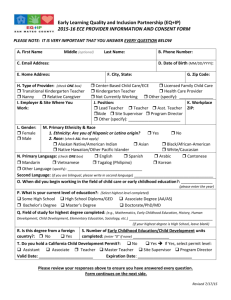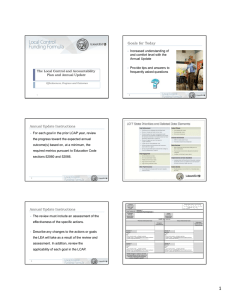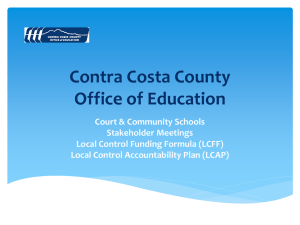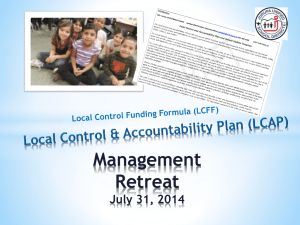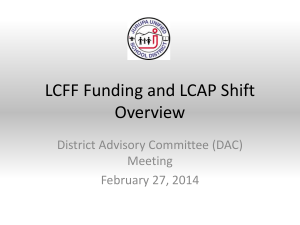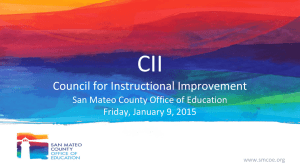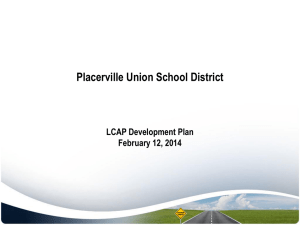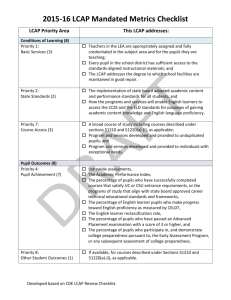LCFF/LCAP Summit 3 - PowerPoint
advertisement
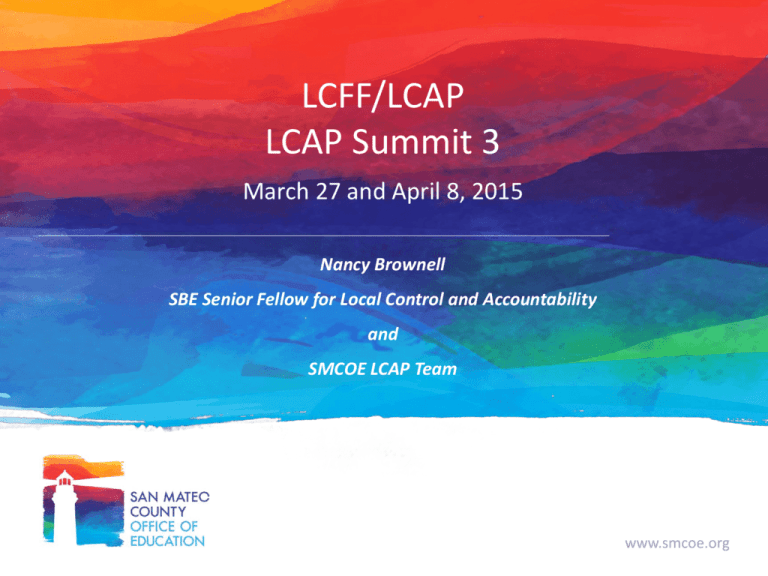
LCFF/LCAP LCAP Summit 3 March 27 and April 8, 2015 Nancy Brownell SBE Senior Fellow for Local Control and Accountability and SMCOE LCAP Team SMCOE Accountability-Innovation-Results www.smcoe.org AGENDA Nancy Brownell – SBE Senior Fellow for Local Control Accountability English Learner Considerations for LCAP Foster Youth Considerations for LCAP Unduplicated and Low-Income pupils Considerations for LCAP Technology and Instructional Technology considerations for LCAP 2015-16 LCAP Approval Timeline www.smcoe.org CALIFORNIA STATE BOARD OF EDUCATION Progress on LCFF/LCAP Implementation: Continuous Learning and Improvement Nancy S. Brownell, Senior Fellow, State Board of Education Staff Local Control and Accountability Team San Mateo LCAP Summit 3 – March 27, 2015 CALIFORNIA STATE BOARD OF EDUCATION Governor Brown’s State of the State CALIFORNIA STATE BOARD OF EDUCATION “We are at a crossroads,” he said. “With big and important new programs now launched and the budget carefully balanced, the challenge is to build for the future, not steal from it, to live within our means and to keep California ever golden and creative, as our forebears have shown and our descendants would expect.” 4 Notable Quotes – State of the State CALIFORNIA STATE BOARD OF EDUCATION “Now – decades later – we have finally created a much fairer system of school funding, called the Local Control Funding Formula. Under the provisions of this law, state funds are directed to school districts based on the needs of their students. Districts will get significantly more funds based on the number of students from foster care, low-income families and non-Englishspeaking parents. This program also breaks with decades of increasing centralization by reducing state control in favor of local flexibility. Clear goals are set, and their enforcement is entrusted to parents and local officials. This puts California in the forefront of educational reform.” 5 Notable Quotes – State of the State CALIFORNIA STATE BOARD OF EDUCATION “The tasks ahead are daunting: making sure that the new system of local control works; recruiting and training tens of thousands of teachers; mastering the Common Core Curriculum; and fostering the creativity needed to inspire students. Teachers need to be held accountable but never forget: they have a tough job to do. They need our encouragement, not endless regulations and micro-management from afar.” 6 LCFF Big Ideas CALIFORNIA STATE BOARD OF EDUCATION • The changes introduced by the Local Control Funding Formula (LCFF) represent a major shift in how California funds Local Educational Agencies (LEAs). • Under LCFF, California funds school districts, charter schools, and county offices of education equally per student with adjustments based on grade levels and demographic characteristics. • LCFF replaces complexity in favor of equity, transparency, and performance. 7 LCFF Big Ideas CALIFORNIA STATE BOARD OF EDUCATION • In conjunction with the new funding formula, we adopted a new system of support and technical assistance for districts. • Founded on annual plans and evaluation rubrics. • Districts develop, adopt and implement 3-year plans to improve student performance. • Builds on a continuous improvement 8 model of accountability. Local Control and Accountability Plans CALIFORNIA STATE BOARD OF EDUCATION • Major changes to a belief and structured finance and student outcome system • Continuum of Connections: Needs Assessment Goals Resource Alignment Services Student Outcomes • Situated in a developing, new accountability system for California • State priorities are the foundation 9 Local Control and Accountability Plans: Guiding Principles CALIFORNIA STATE BOARD OF EDUCATION • Performance-focused – relationship among plans, funding use, outcomes for students • Simplicity and transparency • Student-focused – local identification of needs, provide equitable opportunities • State priorities – define metrics, but rely on local determination of measurement • Stakeholder engagement – parents, students educators, broader community 10 District Implementation and Continuous Improvement Goals and Outcomes CALIFORNIA STATE BOARD OF EDUCATION Reasons for Budget Differences Actions and Services Progress and Needed Changes Schools and High Need Students Measures and Metrics 11 Continuous Planning and Evaluation System District LCAP Development & Updates CALIFORNIA STATE BOARD OF EDUCATION COE Support as Needed COE Assessment of District Performance LAO Report January 20, 2015 District LCAP Adoption & COE Approval District LCAP Implementation 12 8 State Priorities and Related Data Elements Needs Assessment Goals Student Achievement Performance on assessments Academic Performance Index College and Career Readiness English learners becoming reclassified and proficient Advanced Placement Exams passage Prepared through Early Assessment Program Basic Services Rate of teacher mis-assignments Student Access to standardsaligned instructional resources and materials Facilities Course Access Student access and enrollment in 13 courses of study Resource Alignment School Climate Student suspension rates Student expulsion rates Other local measures Parental Involvement Efforts to seek parent input Promotion of parental participation and leadership Services Outcomes Student Engagement School attendance rates Chronic absenteeism rates Middle School dropout rates High School dropout rates High School graduation rates Implementation of State Standards Implementation results for all students, including English learners Other Student Outcomes Other indicators of student performance in courses of study. May include performance and other exams. LCAP Actions and Services CALIFORNIA STATE BOARD OF EDUCATION • Technical and relationship challenges • Measure progress on process and outcomes • Trust is as important as the measurement expectations • Use the local data you have as formative measures, not as a complete design this year • Process for using the metrics also needs to engender trust and rapport 14 Strong Formative Metrics CALIFORNIA STATE BOARD OF EDUCATION • Credible: Are within your sphere of influence or control, and your schools; leadership, and community believe they will contribute to the results. • Feasible: Require data that you can realistically obtain. • Valuable: Answer the “so what” questions, go beyond activities to outcomes and goals. 15 Formative Assessment: Key to Instructional Decisions CALIFORNIA STATE BOARD OF EDUCATION • A process used by teachers and students during instruction that provides feedback to adjust ongoing teaching and learning to improve students’ achievement of intended instructional outcomes. Learning progressions, goals, success criteria Evidence of learning during lessons Collaborative classroom culture Descriptive feedback Self- and PeerAssessment 16 (ELA/ELD Framework, Ch.8, pp. 9, 30; CCSSO, 2008) Formative Progress – Continuous Improvement CALIFORNIA STATE BOARD OF EDUCATION Agree on and implement/fine tune changes. Define Improve Analyze, examine and communicate data, adjust. Actions and services in year 1, and how you will achieve them. Measure Learn Collect information, verify and make inferences, add to data system. 17 LCAP Annual Update Instructions CALIFORNIA STATE BOARD OF EDUCATION • For each goal in the prior year LCAP, review the progress toward the expected annual outcome(s) based on, at a minimum, the required metrics pursuant to Education Code sections 52060 and 52066. • The review must include an assessment of the effectiveness of the specific actions. • Describe any changes to the actions or goals the LEA will take as a result of the review and assessment. In addition, review the applicability of each goal in the LCAP. 18 LCAP Challenges How do we get from here … to here? CALIFORNIA STATE BOARD OF EDUCATION County Office and Local Board approved LCAP, 3-year plan All students leave high school college and career ready; English Learner, high poverty, foster students, successfully served. …and what actions and services will help? 19 Evaluation Rubrics (E.C. 52064.5) • Purpose: CALIFORNIA STATE BOARD OF EDUCATION • Create evaluation rubrics to evaluate strengths and weaknesses and inform support and assistance related to state and local priorities • Process: • Broad input – Rubric Design Group, regional input sessions, policy input sessions, additional stakeholder engagement • Transparency – Conceptual Example (January), Draft (March), Update and Resource Examples (May), Final for Review (July), Final for Adoption (September) • Outcome: • Adoption of evaluation rubrics by October 1, 2015 Evaluation Rubrics Statutory Requirements • To assist local education agencies to identify strengths, weaknesses, and areas that require improvement CALIFORNIA STATE BOARD OF EDUCATION • To assist County Offices of Education to identify school districts and charter schools in need of technical assistance • To assist the State Superintendent in identifying school districts for which intervention is warranted • To reflect a holistic, multidimensional assessment of school district and individual school site performance and include all of the state priorities • To include standards for school district and individual school site performance and expectation for improvement in regard to each of the state priorities Standards for Performance and Improvement CALIFORNIA STATE BOARD OF EDUCATION • The evaluation rubrics are oriented towards changes in outcomes evidenced by improvement and growth • Progress towards Standards: – Growth orientation for state priorities – Include statewide reference points, for metrics with common statewide definitions and data sets, and locally determined reference points for locally determined metrics • Questions about Standards: – – – – How will statewide reference points be crafted? How will local reference points be crafted? How will growth be defined? Will the availability of state-managed data change? • Appendix A provides an overview of the data currently available on a statewide basis • This is an important area to which explicit feedback will be sought regarding the approach to establishing reference points and how they will apply Key Principles for Evaluation Rubrics Design Process CALIFORNIA STATE BOARD OF EDUCATION • Align to the LCFF design principles: (1) studentfocused, (2) equity, (3) transparency, and (4) performance. • Serve as a resource that LEAs find useful to guide reflections and provide helpful ideas to support students. • Support of a continuous improvement process focused on student-level outcomes. • Facilitate reflection that supports local ownership of planning and implementation of actions that support student-level outcomes. 23 Key Principles for Evaluation Rubrics Design Process CALIFORNIA STATE BOARD OF EDUCATION • Not grade nor judge, but provide ways to identify strengths, areas for improvements, and strategies to improve. • Include other resources and tools that in combination support high-quality planning and implementation. • Extend to all strategic planning and implementation efforts. • The evaluation rubrics are not limited to LCAPs. 24 Evaluation Rubrics Address Strengths, Areas in Need of Improvement, Needs Assessment EVALUATION RUBRICS Provide Standards – Improve Outcomes – Guide Practice Progress Assessment Plan Development (Example: LCAP) Progress Monitoring (Example: Annual Update) Plan Revision/ Update Strengths, Areas in Need of Improvement, Needs Assessment Analysis and Attention Student Outcomes Validation Assistance No Growth/ Improvement Growth/ Improvement Overview of the Draft Evaluation Rubrics Data Analysis Outcome Analysis Complements the data analysis component Reflection and further analysis of factors contributing to and/or in need of improvement Practice Analysis Display and analysis of state and local metrics Emphasis on growth with state and local reference points Includes local educational agency (LEA), student subgroup, and school levels data Further reflection regarding efforts to support improvement in outcomes Assists LEAs to identify practices needed to reach state and local outcome expectations Practice Guides and Other Resources Drawn from Institute of Education Sciences Practice Guides System Components CA Collaborative for Educational Excellence CALIFORNIA STATE BOARD OF EDUCATION • Charged with Helping Districts – Improve achievement within the context of the state priorities – Enhance the quality of teaching – Improve district/school-site leadership – Address the needs of priority student populations – Help achieve LCAP goals 27 CA Collaborative for Educational Excellence CALIFORNIA STATE BOARD OF EDUCATION • Members – State Superintendent - Tom Torlakson – SBE Appointee – Sue Burr – County Superintendent (Senate Rules) • Michael Watson – Santa Cruz COE – District Superintendent (Governor) • Sandy Thorstenson – Whittier Union HS – Teacher (Speaker) • Tim Sbranti - Dublin • Riverside County Office of Education Contract 28 Common Goal CALIFORNIA STATE BOARD OF EDUCATION Ensure that students learn what they need to know and do to be successful in life, having been well-taught by competent professionals in adequately resourced schools that are responsive to student needs. 29 Key Purposes of New Accountability System CALIFORNIA STATE BOARD OF EDUCATION • Provide transparent decision making processes in support of student achievement and outcomes. • Focus district and school leaders on significant areas for improvement and raise the sense of urgency to do so. 30 Key Purposes of New Accountability System CALIFORNIA STATE BOARD OF EDUCATION • Report well-timed, accessible and actionable data for use by educators, parents, community members and policymakers. • Drive continuous improvement and allow the state to differentiate the performance of districts and schools in need of support and technical assistance. • Strengthen confidence in the educational system and return on investment. 31 New Accountability System CALIFORNIA STATE BOARD OF EDUCATION • Build on the foundations of LCFF, state priorities and implementation of new student academic standards and assessments • Increase district and school capacity and drive continuous improvement • Focus on a broader set of outcomes than in the past, reflect more clearly what students need in order to be prepared for college, careers, and citizenship 32 New Accountability System CALIFORNIA STATE BOARD OF EDUCATION • Decisions and actions are aligned and consistent towards ensuring students are ready for college and careers • Differentiate the performance of schools and districts in reliable and meaningful ways so they receive appropriate support and assistance • Improve performance across the systems, increase achievement and efficiency, strengthen local capacity 33 This figure shows the elements and their connections to form California’s emerging accountability system. From left to right are Classroom and School Practices, Local Accountability Processes, and State Accountability Process. Each element is shown as an equal sized circle with a trailing tail that wrap around parts of the other elements. The tails do not fully connect, but together form a complete system. Accountability Pieces in Play All the pieces not fully developed yet. Connecting relationships still emerging. CALIFORNIA STATE BOARD OF EDUCATION 35 Collective Accountability and Shared Responsibility CALIFORNIA STATE BOARD OF EDUCATION • • • • Student accountability Parent responsibility Teacher and leader accountability Local school board and superintendent accountability • Higher education accountability • Educator preparation provider accountability • State accountability 36 Long Term Development CALIFORNIA STATE BOARD OF EDUCATION • State Priorities • Local Control and Accountability Plan (LCAP) • Evaluation Rubric Design Process • California Collaborative for Educational Excellence (CCEE) • Smarter Balanced and English Language Proficiency Assessments • Additional Assessments – State and Local 37 Resources • Nancy Brownell – nbrownell@cde.ca.gov CALIFORNIA STATE BOARD OF EDUCATION • State Board of Education Agendas http://www.cde.ca.gov/be/ag/ag/index.asp March Agenda, Item 6 • LCFF – WestEd Channel http://lcff.wested.org/ • CDE LCFF http://www.cde.ca.gov/fg/aa/lc/ • CDE Common Core http://www.cde.ca.gov/re/cc/ • CAASPP http://www.cde.ca.gov/ta/tg/ca/ 38 Special Considerations for Key Subgroups & Issues • English Learners • Foster Youth • Low-income Pupils • Investing in Instructional Technology www.smcoe.org English Learners March 27 and April 8, 2015 Nabila Massoumi, Ed.D., EL Services Coordinator and SMCOE LCAP Team SMCOE Accountability-Innovation-Results www.smcoe.org Outcomes Participants will: Review the required elements of the district’s program(s) for English Learners (ELs) Reflect on the status of the district’s program(s) for ELs Note the changes needed in the district’s 2015-16 LCAP to meet the needs of its ELs www.smcoe.org Program for English Learners - Purpose District’s dual obligation to English Learners: • Program to overcome language barriers (as quickly as possible) • Provide meaningful access to district’s core curriculum so no academic deficits are incurred while learning English 42 www.smcoe.org Programs developed for English learners must: • Be based on scientific research or educational theory • Have adequate resources to fully implement the program • Produce results that show the program is effective 43 www.smcoe.org Ensuring ELs Meaningful and Equal Participation in the District’s Educational Programs include: • Identification of ELs • Provision of ELD • Staffing and Supporting EL program(s) • ELs meaningful access to the district’s CORE curriculum and extracurricular program(s) • Evaluation of the effectiveness of the program(s) for ELs • Serving ELs with special needs • Avoiding unnecessary segregation • Option to “Opt-out” from district’s EL program(s) • Monitoring the entrance and exit criteria from EL program(s) • Meaningful communication with parents of ELs. www.smcoe.org Fact Sheet Jigsaw • Work in Groups of no more than 5 • Assign equal sections per person • Read your section and fill in the columns connected to it on the handout • Share a summary of your sections as well as your reflection of what’s in place and what still needs to be considered for the 2015-16 LCAP 45 www.smcoe.org Team Discussion • What are the current strengths of your LCAP in addressing the 10 programmatic imperatives identified previously? • What the gaps/areas for further specificity regarding the imperatives? • How might you address them? 46 www.smcoe.org Foster Youth Renee Vorrises, Educational Liaison (North) Rosanna Anderson, Educational Liaison (Central) Lauren Sneed, Educational Liaison (South) www.smcoe.org Every child removed from their home grieves that loss no matter what the reason they were removed. www.smcoe.org San Mateo County Foster Youth Services A partnership between San Mateo County Office of Education and San Mateo County Human Services Agency • • • • • • • Advocate for foster youth and their families on educational issues Review/Evaluate transcripts Gather educational records Assist with educational transitions Provide resources and referrals Consult regarding educational issues and FY legislation Provide training to local education agencies, group homes, social services, and probation on educational issues affecting foster youth www.smcoe.org/parents-and-students/foster-youth/ www.smcoe.org LCFF Local Control Funding Formula For LCFF Purposes, the definition for Foster Child is as follows: All children or youth who are the subject of a petition filed under Welfare and Institutions Code (WIC) Section 300 (meaning a court has taken jurisdiction over a child and declared the child to be a dependent of the court due to the presence or risk of abuse or neglect), are included regardless of whether they are living at home or are placed outside the home. Children or youth who are the subject of a petition filed under WIC Section 602 however, (meaning a court has taken jurisdiction over a child July 15, 2014 and declared the child to be a ward of the court due to the child’s violation of certain laws) are included only if they have been ordered by a court to be removed from home pursuant to WIC Section 727 and placed in foster care as defined by WIC Section 727.4(d). http://www.cde.ca.gov/fg/aa/lc/lcfffaq.asp#FOSTER www.smcoe.org Identification of Foster Youth • One of the major issues which districts have faced in the past is how to identify FY • Now with LCFF, new foster reports will be available to districts in CALPADS – Under LCFF, provisions require California Department of Social Services to share data on a weekly basis with the California Department of Education for the purpose of identifying for LEAs the students enrolled in their schools who are FY so that services can be better coordinated and provided to these youth (EC Section 49085). CALPADS Update Flash #95 – CALPADS Foster Reports 5.6 & 5.7 www.smcoe.org Local Recommendations/Youth Engagement For consideration when developing LCAP goals and services for Foster Youth www.smcoe.org Voice of Our San Mateo County Foster Youth • California Youth Connection San Mateo Chapter • Focus Groups Held • Recommendations Made www.smcoe.org Other considerations for LCAP • Increasing attendance of foster youth during standardized testing days, particularly CAHSEE • Contact Key Stakeholders: Social Worker, Probation Officer, Foster Parent • Reducing the number of days from initial enrollment to first day of class- streamlining the process • Trained person at each school site to reach out to youth • One-on-one tutoring for addressing individual class needs and overall “catch-up” • Align school board policies with FY legislation 54 www.smcoe.org Foster Youth Services Supporting School Districts • Provide Professional Development to school districts/sites on the special needs of foster youth • Provide Training at district/school site for staff, faculty, counselors and administrators responsible for FY on Educational Laws regarding foster youth • Consultation/Collaboration 55 www.smcoe.org Resources and Tools For consideration when developing LCAP goals and services for Foster Youth www.smcoe.org Foster Youth Education Toolkit 1. Defining and Identifying Foster Youth and their Education Rights Holders (ERH) 2. Enrolling Foster Youth 3. Determining the Needs of Foster Youth 4. Supporting Foster Youth in School 5. Disenrolling Foster Youth www.smcoe.org California Foster Care Education Law Factsheets AB490 Nonpublic Schools Education Decision Making Rights Functional Behavior Assessments AB 167/216 School Discipline Early Care and Education Special Education Discipline Education for Transition Age Youth Educationally Related Mental Health Special Education Services (ERMHS) www.smcoe.org Website Links and Resources Foster Youth Education Toolkit http://kids-alliance.org/wp-content/uploads/2015/03/EdToolkit.pdf California Foster Care Education Law Factsheets (new – 2015!) http://www.cfyetf.org/publications_11_3259084835.pdf Sample District LCAP for Foster Youth http://kids-alliance.org/wp-content/uploads/2014/02/Sample-District-LCAP-for-Foster-Youth.pdf California’s Partial Credit Model Policy http://kids-alliance.org/wp-content/uploads/2013/12/PCM_WEB_April2014.pdf www.smcoe.org THANK YOU Renee Vorrises, Educational Liaison (North) rvorrises@smcgov.org (650) 877-5603 Rosanna Anderson, Educational Liaison (Central) rjanderson@smcgov.org (650) 802-6510 Lauren Sneed, Educational Liaison (South) lsneed@smcgov.org (650) 599-5972 www.smcoe.org Team Discussion • What are the current strengths of your LCAP in addressing the 5 programmatic imperatives identified previously (from the Toolkit)? • What the gaps/areas for further specificity regarding the imperatives? • How might you address them? 61 www.smcoe.org LCAP Summit 3 Low Income March 27 and April 8, 2015 SMCOE LCAP Team SMCOE Accountability-Innovation-Results www.smcoe.org Outcomes Participants will: Review the LCAP use of the terms: Unduplicated and Low-Income pupils Review how to fund actions and services to support LCAP goals Note the changes needed in the district’s 2015-16 LCAP to meet the needs of its Low-Income students www.smcoe.org Definitions: Unduplicated: “UNDUPLICATED pupil” means a pupil enrolled in a school district or a charter school who is either classified as an English learner, eligible for a free or reduced-price meal, or is a foster youth. EC 42238.02(b) Fiscal Implications for S&C Calculations CALPADS Counts Report CA 1.17 www.smcoe.org Definitions (Cont): Low-Income pupils: “Eligible for free or reduced-price meals” means determined to meet federal income eligibility criteria or deemed to be categorically eligible for free or reduced-price meals under the National School Lunch Program. EC 42238.01 (a) How to assess the educational needs of Low-Income pupils? What LCAP goals are appropriate for Low-Income pupils? www.smcoe.org Determine the LEAs LCAP Low-Income Pupils While observing ALL confidentiality laws: CALPADS Manual: https://www.calpads.ca.gov/Help/UserManual.htm#_Toc410129037 Report 1.17: FRPM/English Learner/Foster Youth – Count Report 1.18: FRPM/English Learner/Foster Youth – Student list www.smcoe.org What needs to be included in the LCAP? ALL resources the LEA allocates to fund the actions and services to meet its LCAP Goals www.smcoe.org LCAP COMMUNICATION TO STAKEHOLDERS ALL resources the LEA allocates to fund the actions and services to meet its LCAP Goals. Federal Revenue Concentration Supplemental BASE Other Revenue 3A & 3B · LCAP Goals to address ALL State Priorities · Actions, Services and its anticipated expenditures to meet the LCAP Goals (2016-2018) · Anticipated Actual Expenditures in the LCAP Update (2014-15) · For ALL pupils · For Low-Income pupils · For English Learners · For Foster Youth · For Reclassified ELs · Other pertinent subgroups 68 www.smcoe.org Team Discussion • What are the current strengths of your LCAP in explicitly addressing the needs of Low-income pupils? • What are the gaps/areas for further specificity regarding services/actions for Low-income pupils? • How might you address them? 69 www.smcoe.org LCAP Summit 3 Investing in Instructional Technology March 27 and April 8, 2015 www.smcoe.org QUESTIONS? www.smcoe.org The Approval Process SMCOE LCAP Team www.smcoe.org Next Steps LCAP Approval www.smcoe.org • Finalize Consultation with stakeholders • Check May revision of proposed State budget (2015-16) and local implications • Invite public comment on draft of the 2015-16 LCAP • Present draft LCAP to PAC and DELPAC Committees • Respond to PAC and DELPAC comments in writing • Hold LCAP and Budget public hearing – (Remember 10-day posting requirement) • Receive LCAP and Budget Board-approval • Submit Board approved LCAP and Budget to SMCOE (within 5 days of Board approval) – no later than June 30. • Receive LCAPs from charter schools (if applicable) www.smcoe.org QUESTIONS? www.smcoe.org LCAP TA Sessions • Window #3: – April 1-24, 2015 • 9-11AM or 2-4PM – Please register here (if you haven’t already): • http://www.signupgenius.com/go/20f0f4facac 23a6fb6-lcap 76 www.smcoe.org
